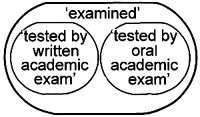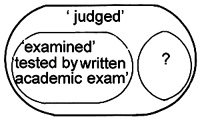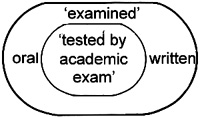An expression is sufficiently precise for a communication situation if it makes unambiguously clear the intended depth of meaning of its assertion to the recipient(s)
Intended depth of meaning refers to the level of conceptual precision of an assertion. When the conceptual precision or clarity is not conveyed unambiguously enough by an expression, it requires more accurate formulation.
For the sake of simplicity we may first illustrate this by a single term that is ambiguous, which is to say it has at least two distinctly different meanings. The term 'underground' can express the different concepts 'subway' and 'resistance movement'. The expression:-
EO "He was working for the underground" is therefore ambiguous. If the communicator of EO meant:-
E1 "He was working for the subway", then EO was not sufficiently precise to convey the intended depth of meaning, because a recipient could have equally well interpreted it as:-
E2 "He was working for the resistance movement."
In this example, then, E1 and E2 are both more precise expressions than EO, The two derived expressions E1 and E2 are not sufficiently equivalent in meaning to make EO unambiguous, while each of them could be interpreted as expressing what EO expresses, depending upon the context and communication situation in which EO was used.
Suppose that EO was uttered in answer to a question about a man in a London Transport uniform 'What is his employment?' In that communication situation it is unlikely that the term 'underground' would be misinterpreted, so that we could say E0 and E1 are sufficiently equivalent in meaning as to make no difference to the recipient, Only under very special circumstances could 'underground' be equivalent to 'resistance movement' in the above communication situation, such as if the uniformed official were a member of some clandestine group at the same time.
One could therefore judge 'He is working for the underground' to be sufficiently precise for the communication situation. Inserting the alternative term 'subway' would make the expression more precise, In English, the term 'subway' refers to pedestrian crossings under roads etc., therefore it would not be a fully appropriate term unless the recipients were Americans. In English a more precise and appropriate term would be 'tube'.
There is a distinct difference between imprecision and generality. For example 'the tube' is not less general than 'the underground', but it is more precise. To be imprecise a term or expression must have different possible interpretations. General terms and expressions can be very precise (such as in the case of scientific generalisations), but can also be imprecise. Basically generality refers to the Inclusion of a broad class of individuals or states of affairs, while imprecision refers to the inclusion of various possible meanings.
[Note: The principle of sufficient precision here is derived from the 'theory of preciseness' developed by Prof. Arne Næss of Oslo University. Ref. "Communication and Argument" Oslo 1971 and "Interpretation and Preciseness". The main difference between Næss' semantical theory of interpretation/definition and the traditional theories of meaning in logic lies in the criterion that underlies their application, namely the practical criterion of whether or not effective communication is achieved thereby. Particularly his definition of 'preciseness' and its practical demonstration of expressions as to their relative vagueness or conceptual clarity. In this book, what was Næss' definition has been altered in form as a principle and also in content insofar as the degree of precision is related to communication situations, thereby introducing the qualification of 'sufficiency'. This is because no standard of absolute precision can usually be conclusively demonstrated, if ever. Nevertheless, I am completely indebted to Arne Næss for the fundamental insight that the principle of sufficient precision expresses, as well as for the method of its demonstration in practical language usage.]
Demonstration of precision
Whether any expression (E0) is imprecise can be shown by comparison
with two or more interpretations of it. The following three steps
are necessary for conclusive demonstration of relative precision of
terms or expressions:-
Step 1 If there is more than one possible intended elation
of an expression (EO), decide whether each of them is a likely Interpretation
of E0. Accept only likely Interpretations before proceeding.
Step 2 Compare each interpretation with the origin expression
(EO) to ensure that no other likely interpretations can be derived
from them that would not also be derivable from BO in the communication
situation that applies.
This second step ensures that the derived expressions are not less
precise than EO, which they could be even while being likely interpretations
of EO. (i.e. 'likely interpretations' are reciprocal). If less precise
than EO, an interpretation would have possible meanings other than
what reasonably can be derived from E0 in such a case E0 would itself
be more precise than the derived interpretation).
Eg) EO "Candidates will be examined for their abilities"
could be sufficiently equivalent in meaning to:-
El "Candidates will be judged as to their abilities."
According to current usage the term 'judged' can include all manner
of decisions from personal evaluation, oral and/ or written examination
as well as evaluation of sporting abilities, behaviour in general
and so on. Therefore there are as many interpretations of El, only
some of which would be sufficiently equivalent in meaning to EO. So
E1 would thus be less precise than EO (and EO more precise than El).
A more precise interpretation of EO could be:-
E2 "Candidates will be tested by written academic examination
for their abilities."
Step 3 Compare each of the interpretations
that remain after applying step 1) and 2) to discover whether their
expressions can be judged to be likely interpretations of one another.
If they cannot, they are then more precise than the origin expression
EO
Let us compare the following two interpretations of EO:-
E2"Candidates will be tested by written academic examination
for their abilities."
E3 "Candidates will be tested by oral academic examination
for their abilities."
As there is a clear difference in meaning between 'written' and 'oral',
E2 and E5 are not sufficiently equivalent in meaning. Therefore both
are more precise than EO. They are also both more precise than E1.The
reason for requiring at least two more precise expressions
than the original one is so as to demonstrate that each is
more precise. This can be illustrated by the use of Venn's diagrams
(modified here for current use):
Let all the possible meanings (interpretations) of the term 'examined'
be represented by an oval circumscribing those interpretations. Within
this oval the two interpretations of the term 'examined' as in E2
and E3 are represented by two smaller ovals-
 |
|
This diagram could be extended to show the relation of the term 'judged' to the other three terms as:-
 |
|
Note: Venn's diagrams can be used as an aid to illustration in such cases, but one should be most careful not to rely on them to solve questions about precision. Problems arise with the diagrams when there is partially-shared meaning between the two more precise terms 'tested by written academic examination' and 'tested by oral academic examination'. In this instance it could actually be done as follows if require:-
 |
While E3 ('Candidates will be tested
by oral academic examination') is more precise than EO, we cannot
thereby conclude that it is completely precise. Full or perfect
precision is doubtless an ideal for such symbol users are mathematicians,
logicians and computer-programmme designers and may be attainable
in certain cases even outside such stringent thought systems. Generally,
however, one will need only to demonstrate sufficient precision
of language usage in practice, which is to say in respect of particular
communications situations. The standard of sufficiency is set by the
principle of sufficient precision. This requires that recipients interpret
the origin expression as making the same assertion as did the communicator.
The 'intended depth of meaning' of a communicator's assertion refers
to the exact assertion that it was the communicator's intention to
convey. This assumes that the communicator did have a clear assertion
in mind, of course. If so, the expression is only sufficiently precise
when it is not likely to convey any other meaning than just that assertion.
Since one cannot 'look into the mind' of other communicators than
oneself, the intended depth of meaning of an expression can only be
assessed by means of common sense, general experience and knowledge
pertinent to the communication situations involved.
The following example illustrates increasing levels of 'depth of intended
meaning' as expressed through increasingly more precise expressions:-
EO 'There will be a political majority in favour of full nuclear
disarmament'.
El 'There will be a parliamentary majority in favour of full nuclear
disarmament'.
(El is more precise than EO because 'political majority' could also
be interpreted as 'over 50% of eligible voters', which is not always
a guarantee of parliamentary majority).
El a 'There will be a constitutionally-representative parliamentary
majority in favour of full nuclear disarmament' (El a) is more precise
than E1 because 'parliamentary majority' could also be interpreted
as 'a parliamentary majority based upon and unconstitutional system
of electoral representation')
El b 'There will be a constitutionally-representative parliamentary
majority behind which at least 50% of all voters clearly stand in
favour of full nuclear disarmament.' El b is more precise than all
the foregoing expressions, for it can be shown that El a can have
other interpretations than El such as El a2 'There will be a constitutionally-representative
parliamentary majority (even without a genuine voter majority) in
favour of full nuclear disarmament.'
The term 'political majority' is obviously a general term, while 'parliamentary
majority' is also general. '. Which is the more general is highly
arguable, for it may occur that a parliamentary majority is greater
than a political majority in some connections, even though at first,
glance 'political' seems, more general than 'parliamentary', That
the above examples of interpretations are increasingly more precise
than EO can be seen by considering the fact that, in each case, exactly
the same number of parliamentary votes could be involved. Therefore
each of the terms of varying levels of precision could include the
same class or main state of affairs.
It is seldom easy to compare terms or
expressions as to their relative degree of generality with any accuracy,
yet it is frequently possible to do so with regards to their degree
of precision by applying the three steps stated above.
The preceding example could be represented by Venn's diagrams as follows:-
EXERCISES (on PRECISION)
1) Consider the expression
EO "Ship owners to take up dumping of nuclear waste again."
Suppose three persons see this as the headline of a newspaper article,
without reading the article itself. In a discussion later one person
asserts that:
E1 "Ship owners are to reconsider dumping of nuclear waste."
The second person disagrees, saying it meant that:
E2 "Ship owners are to raise nuclear waste that was dumped."
The third person has yet another interpretation:
E3 "Ship owners are to recommence dumping of nuclear waste."
Discuss whether El, E2 and E5 are likely interpretations of the expression
EO, and also whether any are more precise than EO, Refer to the steps
in applying the principle of sufficient precision and, if you wish,
illustrate by use of Venn's diagrams,
2) Consider the following discussion about changing attitudes upon
the part of residents towards the increasing number of foreigners
in, their country:
Interviewer: In your opinion has there over the past few years been
an increase in discrimination in this country?
First .foreigner: If you mean an increase in unfair
treatment on account of racial characteristics, then I would, say
that there has.
Second foreigner: I think that residents are more prejudiced against
foreign cultural standards than they were some years ago.
a) State clearly the interpretations that each of the foreigners give
of the term 'discrimination' and say whether you find them to be likely
interpretations of this term in the situation in question.
b) Are the two foreigners' interpretations of the term 'discrimination'
more or less precise than it? Give grounds for your opinion, referring
to the principle of sufficient precision "and the method of its
application.
3) Consider the following paraphrase of a famous statement :-
EO "If East is East and West is West, then the two can never
meet".
Suppose that this is being discussed by an Eastern spiritual leader
and an Eastern politician in connection with the problem of world
peace and that they give each their interpretation of EO as follows:-
Spiritual leader: E1 "So long as Western leaders remain
basically of Western, materialistic mentality there will not be a
sufficient basis for understanding between the East and the West".
Politician: E2 "If the Eastern and Western superpowers
do not become more politically integrated with one another, agreement
on world issues will not become securely established between them".
Consider whether or not the spiritual leader and the politician have
interpreted EO in different ways, arguing whether you regard both
E1 and E2 to be likely interpretations of EO and also to be more precise
than EO.